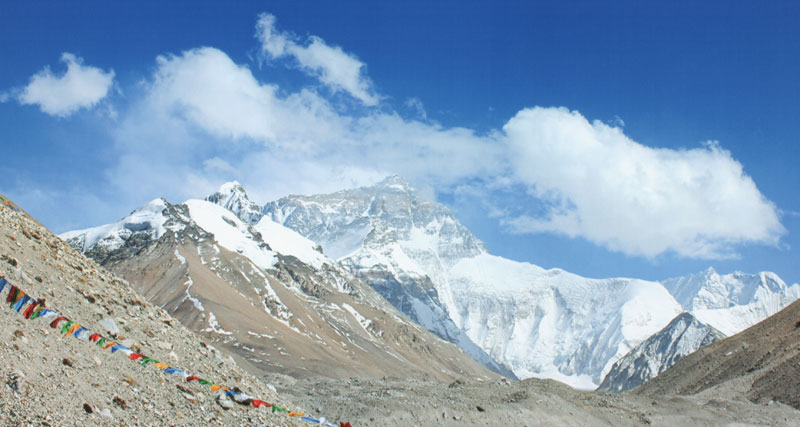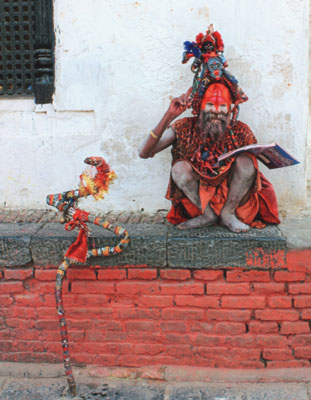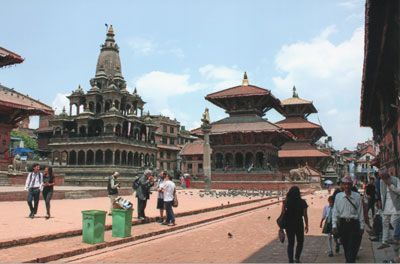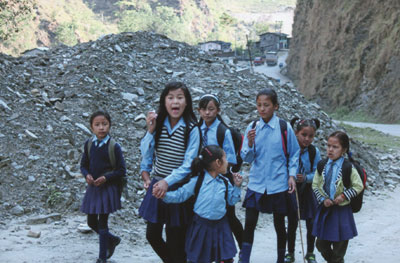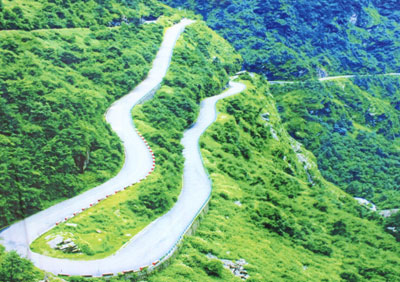To Mt. Everest and beyond
This article appears on page 44 of the December 2014 issue.
For as long as I can remember, Mt. Everest has fascinated me — not only for its lofty height of 29,029 feet but for its ruggedness and the strain it no doubt places on the minds and bodies of those who attempt to scale it. Enormous hardships are faced by the climbers, the Sherpas and the beasts of burden who must toil up the steep slopes and narrow, rocky paths in extreme cold, enduring mind-numbing loss of locomotion due to the brain’s lack of oxygen.
Nevertheless, the human drive to overcome such challenges has driven brave men like Edmund Hillary and his Sherpa guide, Tenzing Norgay, the first to attain the summit in 1953. They opened the way for other brave adventurers, with their ever-advancing
technology.
Today, more than 4,000 people have made it to the summit. However, Chomolungma, as Everest is known by Tibetans, has claimed over 200 lives in the process.
Planning our journey
My wife and I have long discussed making a trek up the mountain, but, at our current age, we had to adjust our ambitions to backpacking partway and hiring a driver and a professional guide with a Land Cruiser-type vehicle to reach the North Base Camp, located at approximately 16,900 feet. These became the broad parameters for our once-in-a lifetime journey.
Like any good expedition leader, I began by seeking out people who had “been there, done that.” In my very wide circle of traveling friends, I could find no one who had.
I then started my online search on Google to find a reputable firm from which I could obtain some reliable information. Many of these firms want to sell you a tour that begins in Lhasa, Tibet, and stops only at a lookout point as the tour bus passes by Everest while heading south on the Friendship Highway toward Kathmandu, Nepal. Since my wife and I had been to Tibet and traveled the Lhasa Plateau a couple of times, and because we really only wanted to travel to the Everest Base Camp in Tibet, our search deepened.
I finally made contact with a firm in Chengdu, China, named Tibet Discovery (phone +86 891 6809260, www.tibetdiscovery.com) and spoke with representatives Bruce, Mary and Bella.
I carefully outlined that we did not want a Lhasa-based tour but wanted to put together a private tour to take us from Kathmandu to Everest Base Camp, with an overnight there, returning to Kathmandu in order to continue our planned around-the-world trip.
I also found a blog called “The Longest Way Home” (www.thelongestwayhome.com), authored by a man named Dave, who writes of his extensive travels and experience in that part of the world. I was able to pose many of my questions to him, and he gave me a lot of very, very good and valuable advice on how to proceed.
I read other online blogs and, being a lifetime subscriber to National Geographic Magazine, found great help in its illustrated magazine The Call of Everest. I also read “Into Thin Air” by Jon Krakauer, a great book and a lot of help!
Hesitations
It bothered me to try to negotiate arrangements for this trip over the Internet with a firm in western China. Two things bothered me greatly. First, it seemed they had a high turnover rate of their employees. Bruce left the company, then Mary, leaving me only Bella to help me over a 6-month period.
I worked with her to construct a suitable culturally oriented itinerary, to acquire all necessary travel documents and permits, obtain English-speaking guides and drivers with appropriate vehicles and reserve overnight accommodations for an 8-night journey beginning May 6, 2014, in Kathmandu, Nepal, and ending with our westbound departure out of there on May 14.
Our drivers and guides did very fine jobs, and both spoke excellent English.
My second concern was that they used PayPal for their payment intermediary. I was concerned that my funds might not reach their Chinese bank account. However, our payment of $1,901 per person for this land-only tour was received without issue.
We then delved into in-depth research of the various cultural events we wanted to attend and the stupas we wanted to visit, and we tried to learn as much as we could about the food available, safe places to stay and the clothing we would need for our ascent to Everest’s North Base Camp.
We carefully watched the political situation between the local Buddhist and Chinese authorities in Tibet for any sign that the border between China/Tibet and Nepal might be closed.
Then came the tragic news of the massive April 18, 2014, avalanche on the west shoulder of the mountain that killed 13 Sherpas and three other Nepalese guides. It was the single deadliest Everest tragedy ever, and the aftermath has raised questions about the largely unregulated way the mountain is run.
Everest has become big business and, along with the seven other highest ascensions in the Himalayas, has become the centerpiece of Nepal’s nearly-half-a-billion-dollar-per-year trekking-and-tourism industry. In 2013, more than 650 people climbed Everest. That was more than twice as many as in 1990.
With the help of large expedition organizations and better meteorological data from the mountain, a climber’s success rate of reaching the summit has risen to over 53%.
Area sights
While this great tragedy and its consequences still hovered over Kathmandu, we had arrived and were ready to start seeing the city and the surrounding area and to begin our medical regimen to get our bodies and blood acclimated to the higher altitudes we would face.
We started taking two Diamox pills per day (one in the morning and one at night) as prescribed by our US travel doctor. We had used the same regimen when we climbed Machu Picchu, Kilimanjaro, Whitney and, in the Philippines, Pinatubo.
We settled in at the Samsara Resort Hotel in Kathmandu’s Thamel neighborhood, then headed off for a lovely Nepalese dinner and folkloric dance performance before getting to bed early.
On our first day, after an American breakfast of pancakes, sausage and eggs, we visited the Swayambhunath Stupa (Monkey Temple) and nearby Durbar Square, including the legendary Kasthamandap Shrine and the Hanuman Dhoka Palace.
There was much burning of incense, painting with chalk on the sidewalks, body piercing and sacrificing of chickens and other animals going on in the vast courtyard of the stupa. All of this was being watched by the monkeys and the “eyes of Buddha” that are painted below the gold-plated, ornamented top spire of the stupa.
After another big American breakfast, we were off the next day to see Pashupatinath, a Hindu temple on the bank of the Bagmati River. We walked in and, in absolute awe, observed a cremation service taking place on the banks of this holy river.
We watched the entire process — the washing of the body in the holy water, the building and blessing of the wooden pyre, the fire being lighted, the stirring of the ashes and the placement of the body on the fire bed.
The oldest son circled the fire bed to insure that the cremation was complete, and the priest gathered the ashes and presented them to the surrounding family members in a suitable container. Most of the cremains were strewn upon the waters of the holy river.
In all our travels, this was our first up-close viewing of this holiest of Hindu rituals. (We had viewed it from afar in Varanasi, India, while floating on the Ganges River.)
To the mountain!
Early on our fourth day we were off to the mountain. We were picked up by our driver and guide at 6 a.m. and left Kathmandu for Kodari, where we would cross the border into Tibet via the Friendship Bridge, meet up with our Tibetan driver and guide, go through all of the Tibetan entrance formalities and change vehicles.
It was a 6-hour drive up very narrow, curving roads through rough terrain, but we made our rendezvous on time.
We left our Nepalese colleagues and carried our luggage and documents across the bridge as our guides reported by cell phone our whereabouts on the half-mile trek to the border. We linked up with the Tibetans, and with their experienced help we were able to clear Immigration by 2 p.m.
We then proceeded about 12 kilometers to the border city of Zhangmu, where we lodged in the Zhangmu Hotel.
Zhangmu is a very busy border town built into steep mountainous terrain. The roads were narrow and curving, and the traffic was really a mess, with hardly any police presence to untangle it.
We departed the next day at 6 a.m. for a 10-hour drive to the Mt. Everest Base Camp (EBC) and the Rongphu Monastery for our overnight stay. Once we cleared the bus/truck/car/pedestrian chaos of Zhangmu, we followed the curving, narrow roads for about two hours, passing lush green, jungle-type vegetation, lots of bridges and tunnels and very few intersections.
As we cleared the tree line, the terrain became a tan, rocky, barren desert, like the countryside. We saw many herds of goats, sheep and yaks trying to find food in the tundra-like soil.
About noon we reached a major pass where the Friendship Highway actually leaves the foothills and passes through a valley with extensive farming fed by snowmelt streams, the very fertile, black soil left from the retreat of old glaciers.
After a lunch of pancakes and a topping off of our fuel load in the small village of Shegar, we turned east off the paved highway onto a dry, dusty, rocky, potholed dirt road — the only road to the EBC.
Reaching our goal
We arrived at the Rongphu Monastery about 4 p.m. knowing we still had to ride a public bus 5 kilometers to our final destination. We hopped on the bus and paid our $5, as we needed to get to the EBC while we still had good sunlight and there was no storm on the top of Everest or the surrounding peaks.
Upon arrival at the EBC, we took a deep breath, did high fives and dug out the cameras. After all of the planning, we were there! What a great feeling it was, even though we were a little lightheaded from the altitude and we were very cold with the 0°F temperature and 30-mph winds.
However, getting to the EBC bus stop was not the end of our journey, as we had another major trail to climb to get some even better pictures. It was called the “Photo Platform,” and it required us to traverse another very steep and rocky trail — but it was worth it!
We hung around to get some pictures of beautiful Everest as the sun set in the west. As it disappeared, we retreated by bus back down to the monastery for a snack (we carried along our own fresh water and snacks) and to see where we would be housed for the night.
Boy, were we in for a surprise!
One rough night
We discovered that we would be bunking with visiting Buddhist monks who had, in most cases, “trekked” to this holy mountain.
The room was about 10 feet by 10 feet, with no running water, no heat, no bathroom or sanitary toilet and little protection from the outside weather conditions, as the only window in the room was broken and covered only by an old woven rug. We had one 40-watt lightbulb, operated by a twist switch that was connected to a series of 220V electrical wires strung up by the door. Needless to say, we were concerned about the conditions, but we learned that we were just experiencing the same conditions under which the monks live all year.
We did finally get a thermos bottle of hot water, a tin basin for washing (though no towels or soap) and a metal trash can and some plastic bags to use as a toilet. My wife and I just laughed and made the best of this unique situation.
We had lumpy twin beds with two thick comforters on them, so we kept all of our cold-weather clothing on, including our thermal socks plus another pair of socks and our boots, but we still froze in the windy, -10°F environment.
It was too cold for us to really sleep, even with all of our cold-weather gear on, but we survived for an early-morning rendezvous with Everest as the sun rose. What a beautiful sight! We concluded that it was all worth it.
After more pictures of the yaks and the monastery, we started back toward Kathmandu. Since we took the exact same track back to Zhangmu, we overnighted in the same hotel in which we’d stayed on the way up. The next morning we slept in and had a leisurely breakfast of eggs, sausage and toast, as we were not scheduled to meet with our Nepalese guide and driver on the south side of the bridge until noon.
After the usual distribution of gratuities, we bid our Tibetan colleagues good-bye and met our trusted guide and driver in Kodari right on schedule. It was a long, winding, dusty trip back to Kathmandu, but we made it.
At 7 a.m. we headed to the Kathmandu airport for our trip westward to Yemen by way of Doha, Qatar. We disappeared into the airport terminal, happy with our visit to Everest and very pleased with what we had seen and the people we had met.

